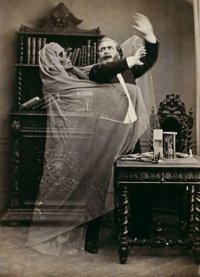Multiple exposure
From The Art and Popular Culture Encyclopedia

Illustration: Henri Robin and a Specter, 1863 by Eugène Thiébault
- See also, Double Exposure (band), an American band from the disco era.
|
Related e |
|
Featured: |
In photography and cinematography, a multiple exposure is the superimposition of two or more exposures to create a single image, and double exposure has a corresponding meaning in respect of two images. The exposure values may or may not be identical to each other.
Contents |
Overview
Ordinarily, cameras have a sensitivity to light that is a function of time. For example, a one second exposure is an exposure in which the camera image is equally responsive to light over the exposure time of one second. The criterion for determining that something is a double exposure is that the sensitivity goes up and then back down. The simplest example of a multiple exposure is a double exposure without flash, i.e. two partial exposures are made and then combined into one complete exposure. Some single exposures, such as "flash and blur" use a combination of electronic flash and ambient exposure. This effect can be approximated by a Dirac delta measure (flash) and a constant finite rectangular window, in combination. For example, a sensitivity window comprising a Dirac comb combined with a rectangular pulse, is considered a multiple exposure, even though the sensitivity never goes to zero during the exposure.
Double exposure
Analogue
In photography and cinematography, multiple exposure is a technique in which the camera shutter is opened more than once to expose the film multiple times, usually to different images. The resulting image contains the subsequent image/s superimposed over the original. The technique is sometimes used as an artistic visual effect and can be used to create ghostly images or to add people and objects to a scene that were not originally there. It is frequently used in photographic hoaxes.
It is considered easiest to have a manual winding camera for double exposures. On automatic winding cameras, as soon as a picture is taken the film is typically wound to the next frame. Some more advanced automatic winding cameras have the option for multiple exposures but it must be set before making each exposure. Manual winding cameras with a multiple exposure feature can be set to double-expose after making the first exposure.
Since shooting multiple exposures will expose the same frame multiple times, negative exposure compensation must first be set to avoid overexposure. For example, to expose the frame twice with correct exposure, a −1 EV compensation have to be done, and −2 EV for exposing four times. This may not be necessary when photographing a lit subject in two (or more) different positions against a perfectly dark background, as the background area will be essentially unexposed.
Medium to low light is ideal for double exposures. A tripod may not be necessary if combining different scenes in one shot. In some conditions, for example, recording the whole progress of a lunar eclipse in multiple exposures, a stable tripod is essential.
More than two exposures can be combined, with care not to overexpose the film.
Digital
Digital technology enables images to be superimposed over each other by using a software photo editor, such as Adobe Photoshop or GIMP. These enable the opacity of the images to be altered and for an image to be overlayed over another. They also can set the layers to multiply mode, which 'adds' the colors together rather than making the colors of either image pale and translucent. Many digital SLR cameras allow multiple exposures to be made on the same image within the camera without the need for any external software.
Long exposures
With traditional film cameras, a long exposure is a single exposure, whereas with electronic cameras a long exposure can be obtained by integrating together many exposures. This averaging also permits there to be a time-windowing function, such as a Gaussian, that weights time periods near the center of the exposure time more strongly. Another possibility for synthesizing long exposure from multiple-exposure is to use an exponential decay in which the current frame has the strongest weight, and previous frames are faded out with a sliding exponential window.
Scanning film with multiple exposure
Multiple exposure technique can also be used when scanning transparencies like slides, film or negatives using a film scanner for increasing dynamic range. With multiple exposure the original gets scanned several times with different exposure intensities. An overexposed scan lights the shadow areas of the image and enables the scanner to capture more image information here. In contrary an underexposed scans allows to gather more details in the light areas. Afterwards the data can be calculated into a single HDR image with increased dynamic range.
Among the scanning software solutions which implement multiple exposure are VueScan and SilverFast.
See also

